
Illustrative Math Alignment: Grade 8 Unit 1
Rigid Transformations and Congruence
Lesson 12: Congruent Polygons
Use the following Media4Math resources with this Illustrative Math lesson.
| Thumbnail Image | Title | Body | Curriculum Topic |
|---|---|---|---|
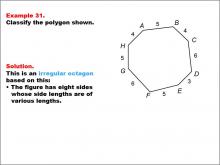
|
Math Example--Polygons--Polygon Classification: Example 31 | Math Example--Polygons--Polygon Classification: Example 31TopicPolygons DescriptionThis example showcases an irregular octagon with sides of varying lengths labeled as 4, 5, 6, and 3. It demonstrates that not all eight-sided figures are regular, emphasizing the importance of equal side lengths in the classification of regular polygons. Polygon classification is a crucial topic in geometry that helps students distinguish between regular and irregular shapes. This collection of examples provides a comprehensive look at various types of octagons, highlighting the differences between regular and irregular polygons based on side lengths. |
Definition of a Polygon |

|
Math Example--Polygons--Polygon Classification: Example 32 | Math Example--Polygons--Polygon Classification: Example 32TopicPolygons DescriptionThis example presents an irregular octagon with sides labeled as w, x, y, z, and u, indicating varying lengths. It illustrates another case of an irregular octagon, demonstrating that the presence of different variables for side lengths suggests irregularity. Understanding polygon classification is crucial in geometry as it helps students recognize and categorize shapes based on their properties. This collection of examples highlights the importance of considering side lengths when determining the regularity of octagons. |
Definition of a Polygon |
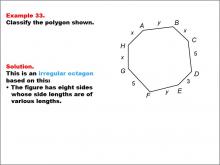
|
Math Example--Polygons--Polygon Classification: Example 33 | Math Example--Polygons--Polygon Classification: Example 33TopicPolygons DescriptionThis example features an octagon with sides labeled as x, y, 5, and 3. The sides are of varying lengths, indicating it is irregular. It demonstrates how a combination of variables and specific numeric values can be used to show irregularity in polygons. Polygon classification is a fundamental concept in geometry that helps students analyze and categorize shapes based on their properties. This collection of examples provides insights into how partial information about side lengths can be used to determine the irregularity of octagons. |
Definition of a Polygon |
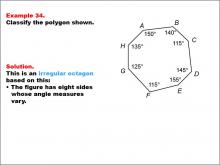
|
Math Example--Polygons--Polygon Classification: Example 34 | Math Example--Polygons--Polygon Classification: Example 34TopicPolygons DescriptionThis example showcases an octagon with angles labeled as 150°, 140°, 115°, 145°, 155°, 115°, 125°, and 135°. The angles vary, indicating it is irregular. It demonstrates that irregularity in polygons can be determined by examining angle measures alone. Understanding polygon classification is essential in geometry as it helps students recognize and categorize shapes based on their properties. This collection of examples highlights the importance of angle measures in determining the regularity of octagons, showing that even if side lengths are not given, angle information can be sufficient for classification. |
Definition of a Polygon |
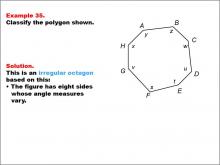
|
Math Example--Polygons--Polygon Classification: Example 35 | Math Example--Polygons--Polygon Classification: Example 35TopicPolygons DescriptionThis example presents an octagon with sides labeled as x, y, z, w, u, t, s, and v. The sides are of varying lengths and angles, indicating it is irregular. It illustrates how using different variables for both side lengths and angles can suggest irregularity in a polygon. Polygon classification is a crucial topic in geometry that helps students distinguish between regular and irregular shapes. This collection of examples provides a comprehensive look at various types of octagons, highlighting the importance of considering both side lengths and angle measures in determining regularity. |
Definition of a Polygon |
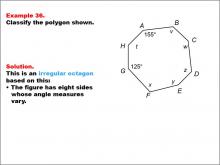
|
Math Example--Polygons--Polygon Classification: Example 36 | Math Example--Polygons--Polygon Classification: Example 36TopicPolygons DescriptionThis example features an octagon with angles labeled as 155° and 125°, and other angles labeled with variables t, v, w, x, y, and z. The angles vary, indicating it is irregular. It demonstrates how a combination of specific angle measures and variables can be used to show irregularity in polygons. Understanding polygon classification is essential in geometry as it helps students recognize and categorize shapes based on their properties. This collection of examples highlights the importance of angle measures in determining the regularity of octagons, showing that even partial information can be sufficient for classification. |
Definition of a Polygon |
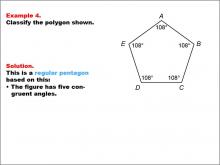
|
Math Example--Polygons--Polygon Classification: Example 4 | Math Example--Polygons--Polygon Classification: Example 4TopicPolygons DescriptionThis example showcases a pentagon with each angle labeled as 108 degrees, indicating congruent angles. It demonstrates that a regular pentagon can be identified not only by equal side lengths but also by equal angle measures. Understanding polygon classification is crucial in geometry as it helps students recognize and categorize shapes based on their properties. This collection of examples highlights different aspects of regular pentagons, emphasizing both side length and angle measure as defining characteristics. |
Definition of a Polygon |
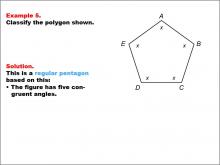
|
Math Example--Polygons--Polygon Classification: Example 5 | Math Example--Polygons--Polygon Classification: Example 5TopicPolygons DescriptionThis example presents a pentagon labeled with vertices A, B, C, D, and E, with each side marked with an "x" to indicate equal length. It reinforces the concept of a regular pentagon by visually representing the equality of all sides. Polygon classification is a fundamental topic in geometry that helps students understand the properties and relationships of different shapes. This collection of examples provides various representations of regular pentagons, emphasizing the importance of side length equality in classification. |
Definition of a Polygon |
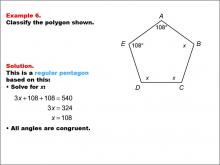
|
Math Example--Polygons--Polygon Classification: Example 6 | Math Example--Polygons--Polygon Classification: Example 6TopicPolygons DescriptionThis example features a pentagon labeled with vertices A, B, C, D, and E, where two angles are marked as 108 degrees, and the other angles are marked as "x". It demonstrates how to determine if a pentagon is regular by solving for the unknown angle measures. Understanding polygon classification is essential in geometry as it helps students analyze and categorize shapes based on their properties. This collection of examples highlights different aspects of regular pentagons, emphasizing both side length and angle measure as defining characteristics. |
Definition of a Polygon |
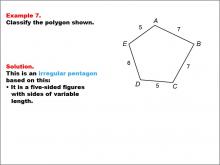
|
Math Example--Polygons--Polygon Classification: Example 7 | Math Example--Polygons--Polygon Classification: Example 7TopicPolygons DescriptionThis example showcases a pentagon labeled with vertices A, B, C, D, and E, where the sides have different lengths: 5, 7, 7, 5, and 6 units. It illustrates an irregular pentagon, demonstrating that not all five-sided figures are regular. Polygon classification is a crucial topic in geometry that helps students distinguish between regular and irregular shapes. This collection of examples provides a comprehensive look at various types of pentagons, highlighting the differences between regular and irregular polygons based on side lengths and angle measures. |
Definition of a Polygon |
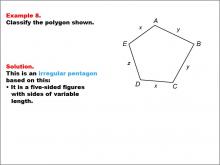
|
Math Example--Polygons--Polygon Classification: Example 8 | Math Example--Polygons--Polygon Classification: Example 8TopicPolygons DescriptionThis example presents a pentagon labeled with vertices A, B, C, D, and E, where the sides are marked with variables x, y, and z, indicating different lengths. It demonstrates another instance of an irregular pentagon, emphasizing that side length variation results in irregularity. Understanding polygon classification is crucial in geometry as it helps students recognize and categorize shapes based on their properties. This collection of examples highlights the differences between regular and irregular pentagons, focusing on side length as a key determining factor. |
Definition of a Polygon |

|
Math Example--Polygons--Polygon Classification: Example 9 | Math Example--Polygons--Polygon Classification: Example 9TopicPolygons DescriptionThis example features a pentagon labeled with vertices A, B, C, D, E, where the sides are labeled as y, z, 5, 4, and x. It illustrates another case of an irregular pentagon, demonstrating that the presence of different side lengths, including both numeric and variable representations, results in irregularity. Polygon classification is a fundamental concept in geometry that helps students analyze and categorize shapes based on their properties. This collection of examples provides a comprehensive look at various types of pentagons, emphasizing the importance of side length equality in determining regularity. |
Definition of a Polygon |

|
MATH EXAMPLES--Teacher's Guide: Polygon Classification | MATH EXAMPLES--Teacher's Guide: Polygon Classification
This set of tutorials provides 36 examples of how to classify polygons based on side and angle characteristics. This is part of a collection of teacher's guides. To see the complete collection of teacher's guides, click on this link. Note: The download is a PDF file.Related ResourcesTo see resources related to this topic click on the Related Resources tab above. |
Definition of a Polygon |

|
Video Transcript: Geometry Applications: Polygons | Video Transcript: Geometry Applications: Polygons
This is the transcript for the video of same title. Video contents: In this program we explore the properties of polygons. We do this in the context of two real-world applications. In the first, we look at Islamic tile patterns as examples of regular polygons. We explore how such intricate patterns were created using a compass and straight edge. In the second application we look at composite figures, specifically in the context of the design of the Petronas Towers in Indonesia. |
Applications of Polygons |

|
Video Transcript: Geometry Applications: Polygons, Segment 1: Introduction | Video Transcript: Geometry Applications: Polygons, Segment 1: Introduction
This is the transcript for the video of same title. Video contents: The Pentagon is one of the most famous polygon-shaped buildings in the world. But why was this shape chosen over a more straightforward quadrilateral shape? We briefly explore the properties of pentagons and use this as a way of introducing the key concepts throughout the program. |
Applications of Polygons |

|
Video Transcript: Geometry Applications: Polygons, Segment 2: Properties of Polygons | Video Transcript: Geometry Applications: Polygons, Segment 2: Properties of Polygons
This is the transcript for the video of same title. Video contents: In the ancient city of Marrakesh polygons are on display. As part of the Islamic tile work prevalent throughout the Middle Ages, Marrakesh provides an opportunity to explore the properties of polygons, and how these properties are taken advantage of in the intricate designs found throughout this fascinating city. |
Applications of Polygons |

|
Video Transcript: Geometry Applications: Polygons, Segment 3: Composite Figures | Video Transcript: Geometry Applications: Polygons, Segment 3: Composite Figures This is the transcript for the video of same title. Video contents: The Petronas Towers in Indonesia provide an opportunity to explore the composite shapes used in the design of the towers. This is part of a collection of video transcript from the Geometry Applications video series. To see the complete collection of transcripts, click on this link.Note: The download is a PDF file.Video Transcript LibraryTo see the complete collection of video transcriptsy, click on this link. |
Applications of Polygons |
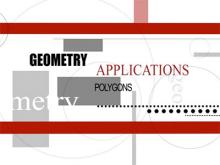
|
VIDEO: Geometry Applications: Polygons | VIDEO: Geometry Applications: Polygons
TopicPolygons |
Applications of Polygons |

|
VIDEO: Geometry Applications: Polygons, 1 | VIDEO: Geometry Applications: Polygons, 1
TopicPolygons DescriptionThis segment introduces polygons through the Pentagon's design. The building’s advantages include increased perimeter and accessibility due to its five-sided structure, illustrating how polygons solve real-world design challenges. Key concepts include perimeter, angles, and design versatility. Relevance to Topic: This video explains and highlights various applications of polygons in real-life scenarios and mathematical contexts, providing valuable insights for understanding geometric concepts. |
Applications of Polygons and Definition of a Polygon |
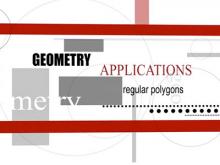
|
VIDEO: Geometry Applications: Polygons, 2 | VIDEO: Geometry Applications: Polygons, 2
TopicPolygons DescriptionThe segment explores Islamic art’s reliance on geometric patterns formed by regular polygons. It demonstrates how artisans used compasses and straightedges to create precise designs, highlighting properties like congruent sides and angles, and applications in tiling and architecture. Relevance to Topic: This video explains and highlights various applications of polygons in real-life scenarios and mathematical contexts, providing valuable insights for understanding geometric concepts. |
Applications of Polygons and Definition of a Polygon |
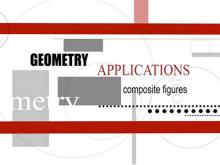
|
VIDEO: Geometry Applications: Polygons, 3 | VIDEO: Geometry Applications: Polygons, 3
TopicPolygons DescriptionComposite figures in architecture, like the Petronas Towers, combine polygons to form complex shapes. This segment examines patterns like overlapping squares and calculates areas using properties of triangles and hexagons. Applications include architectural symmetry and efficiency. Relevance to Topic: This video explains and highlights various applications of polygons in real-life scenarios and mathematical contexts, providing valuable insights for understanding geometric concepts. |
Applications of Polygons and Definition of a Polygon |

|
Worksheet: Crossword Puzzle--Quadrilaterals | Worksheet: Crossword Puzzle--Quadrilaterals
This is part of a collection of math worksheets that are crossword puzzles of math vocabulary. To see the complete worksheet collection on this topic, click on this link. Note: The download is a PDF file.Related ResourcesTo see additional resources on this topic, click on the Related Resources tab.Worksheet LibraryTo see the complete collection of Worksheets, click on this link. |
Definition of a Quadrilateral |

|
Worksheet: Identifying Shapes, Worksheet 1 | Worksheet: Identifying Shapes, Worksheet 1
This is part of a collection of math worksheets on the topic of geometric shapes. To see the complete worksheet collection on this topic, click on this link. Note: The download is a PDF file.Related ResourcesTo see additional resources on this topic, click on the Related Resources tab.Worksheet LibraryTo see the complete collection of Worksheets, click on this link. |
Definition of a Circle, Definition of a Polygon and Definition of a Triangle |

|
Worksheet: Identifying Shapes, Worksheet 2 | Worksheet: Identifying Shapes, Worksheet 2
This is part of a collection of math worksheets on the topic of geometric shapes. To see the complete worksheet collection on this topic, click on this link. Note: The download is a PDF file.Related ResourcesTo see additional resources on this topic, click on the Related Resources tab.Worksheet LibraryTo see the complete collection of Worksheets, click on this link. |
Definition of a Circle, Definition of a Polygon and Definition of a Triangle |

|
Worksheet: Identifying Shapes, Worksheet 3 | Worksheet: Identifying Shapes, Worksheet 3
This is part of a collection of math worksheets on the topic of geometric shapes. To see the complete worksheet collection on this topic, click on this link. Note: The download is a PDF file.Related ResourcesTo see additional resources on this topic, click on the Related Resources tab.Worksheet LibraryTo see the complete collection of Worksheets, click on this link. |
Definition of a Circle, Definition of a Polygon and Definition of a Triangle |

|
Worksheet: Identifying Shapes, Worksheet 4 | Worksheet: Identifying Shapes, Worksheet 4
This is part of a collection of math worksheets on the topic of geometric shapes. To see the complete worksheet collection on this topic, click on this link. Note: The download is a PDF file.Related ResourcesTo see additional resources on this topic, click on the Related Resources tab.Worksheet LibraryTo see the complete collection of Worksheets, click on this link. |
Definition of a Circle, Definition of a Polygon and Definition of a Triangle |